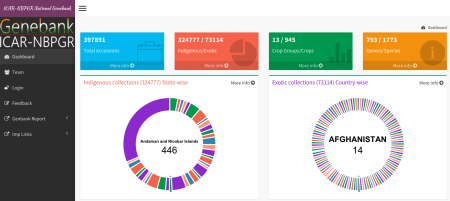- FAO has guidelines for making sure climate adaptation plans include crop diversity.
- A new agricultural biodiversity newsletter for your reading pleasure.
- And a new blog of global sustainability issues from Jonathan Foley.
- The Beaver Dam pepper back from the brink.
- Nice set of slides summarizing the Plant Treaty.
- The traditional Thanksgiving save-heirloom-turkeys story.
- Farming changed people.
- Crop elders?
- Women speak out about traditional African veggies.
NBPGR’s genebank dashboard takes a bow
Good to hear ((From our moles in New Delhi.)) that the National Bureau of Plant Genetic Resources in India has a new online “dashboard” summarizing data from its genebank, one of the largest in the world. ((Though notice the mismatch between the total numbers of accessions on the dashboard and on WIEWS.))

There is a separate PGR Portal for searching the collection, though apparently only on basic characterization data so far. Except for wheat, that is, where you can search for a long list of phenotypic characters.
Clearly lots of work going on lately at NBPGR on getting their data out there. But when will we see them on Genesys?
Breeding locally for local cooks
I’m not sure if we’ve ever linked to the Culinary Breeding Network before. This is a bunch…
…of plant breeders, seed growers, fresh market farmers, chefs and produce buyers engaged in developing and identifying varieties and traits of culinary excellence for vegetable crops in the Pacific Northwest region.
It came to mind because they have a cool, very informative Instagram account, as you can see from a post from a couple of days back…
…and because of yesterday’s post here on how to measure diversity. As I tried to say at the time, sometimes, for all its faults, number of varieties can be a useful metric. And even when it’s not, the names of the varieties are often a lot of fun.
Answering the big genebank questions
A couple of important conferences are coming up and, as readers know, we like to keep on top of such things. So if you’re going, and would like to blog for us, or are thinking of tweeting the proceedings, let us know. Some big questions are being pondered, so it should be fun.
First on the agenda is the Tri-Societies meeting, this year in Minneapolis, on 15-18 November. ((Wow, that’s next week.)) With that, the conoscenti will know, goes the award of the Frank N. Meyer Medal for Plant Genetic Resources, which on this occasion will be presented to Dr Paul Gepts, who I believe is an occasional reader of our blog. Congratulations to Paul, who will deliver a lecture entitled A More Intensive Use of Crop Genetic Resources? Hopeful Future or Business As Usual? The answer seems, perhaps not surprisingly, to depend on more and better data.
Then in January there is PAG XXIV in San Diego and its Genomics of Genebanks workshop. Particularly intriguing is a talk from our friends at the International Potato Center, who ask Are you getting what you ordered from your genebank? The answer to that question seems to be: not always, but we’re working on it. Somebody mention better data?
Nibbles: Apple duo, Biofortified lentil, Wild sweet potatoes, African supermarkets, Trees on farms, Botanic gardens history, Funny honey, Spice trade, Byzantine bread, Seed longevity, Edible wilds
- In remembrance of apples past.
- What makes for an “outstanding lentil“?
- Sweet potatoes finally get a taste of the wild.
- A tree for every season: ICRAF pushing trees both local and exotic.
- Can Zambian supermarkets support local farmers AND make money? Should get some of those tree products in there.
- Touring the oldest botanical gardens would make for a great round-the-world trip.
- Though I’d probably want to add a quick diversion to taste hallucinogenic honey in Nepal.
- ‘Twas pepper built Venice. That and bread.
- Defence-related genes important in seed longevity.
- What the heck are microgreens? And will they be discussed at the International Symposium on Biodiversity and Edible Wild Species in Turkey next November?